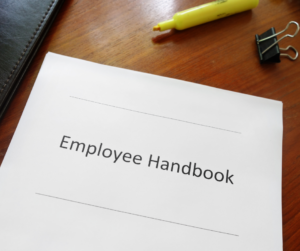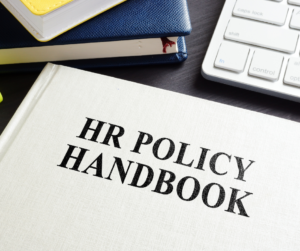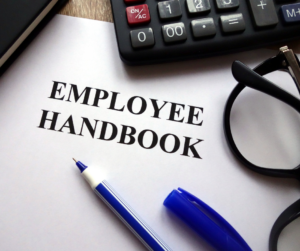Mary E. Marshall's Blog
May 3, 2023
Employment Practices: What You Need to Spell Out – Part Five
 There are a lot of things that need to be covered in your Employee Handbook, and this week we continue the deep dive into the topics you need to have covered.
There are a lot of things that need to be covered in your Employee Handbook, and this week we continue the deep dive into the topics you need to have covered.
Insurance
You should align yourself with a good broker or insurance company that can offer a competitive package to employees. Generally speaking, the larger your company, the more competitive you can be with this package, but again, make sure it’s in alignment with your values. If you’re a smaller company and can’t afford a rich benefits package, offer a flex plan or cafeteria plan that you put pretax money into for medical benefits. Even if you’re small, try to find some way to help employees out.
Auto
Make sure you have a clear auto policy if you have employees who use either their own cars or company vehicles for work. If employees use their own cars, they will need to carry their own insurance and you’ll need to see a copy of their policy, but you’ll also need to compensate them for the wear and tear on their car. The easiest way to calculate an auto allowance is simply to give employees a flat rate. For example, you might allot $500 a month, or more or less depending on the amount of driving and the type of car. Or you can simply reimburse for mileage after the employee submits an expense report. I’ve seen several cases of “creative” expense reports when it comes to mileage, so, if you don’t want to get into the “spy” business, just go with an allowance. Check with your accountant to be sure you’re doing this correctly and withholding tax if applicable.
Reimbursements
Decide how you’ll reimburse your employees for expenses. Make sure the system is easy to follow and put it in writing. That way, if an employee says his dog ate the receipts, you can simply point to the policy that says that, in order to be reimbursed, employees must submit receipts.
401K/Retirement
Even if your business is too small to contribute to a 401K or pension plan of some sort, you can set one up so that your employees can contribute themselves. It’s a good idea to help employees with savings and this gives them an avenue to do so.
Employee Assistance Program
This is an outside service that can provide assistance to employees when they’re having personal problems at home or sometimes at work. You usually pay a fee per employee and then employees have a resource to go to when they’re in trouble. Employee assistance programs are usually confidential unless there’s a potential risk to the business. If the employee needs ongoing counseling, they’ll be referred to another provider, usually at the employee’s expense.
Company Property and Privacy Policies
These are all the policies that will protect you when employees use company equipment. Basically, you want to define how employees are to use anything the company owns and what happens if the policy is violated. This is one part of the handbook you really want to make sure your employees understand. Have your employees acknowledge that they understand this policy and also print it as a separate form that you post visibly in several places.
Internet
We’ve all heard stories or had experience with an employee who spends hours surfing the net instead of working. Today there are all sorts of very sophisticated software products available to companies who want either to prevent employees from using the Internet or to monitor how they use it. In most cases these are good for you because they protect you from liability in the event an employee does something wrong or illegal while using your equipment. First, decide which employees need to use computers, and then decide which sort of software you need to install for prevention or monitoring. Make sure employees know you are monitoring their computer use and put the policy in writing. A local hospital installed prevention software on computers in the doctor’s lounge without notifying employees. Several doctors then complained that something was wrong with the computers because suddenly they weren’t able to access all the sites they used to. As it turned out, those were the computers that some doctors were using to access adult content. Who knew.
Computers
Computers are the property of the company and therefore you are liable if they are used inappropriately. For this reason, I recommend that employees be aware that you can track and record anything they do on company computers and make sure they have no expectation of privacy. Some will say that, while they are on break or off hours, they should be able to do what they want but I disagree. You just don’t want to be responsible for non-work-related activity on your equipment period.
Voicemail
As with computers, there should be no expectation of privacy on company phones and voicemail.
Excerpted from my book, “Putting Together the Entrepreneurial Puzzle: The Ten Pieces Every Business Needs to Succeed.” Available here on Amazon.
The post Employment Practices: What You Need to Spell Out – Part Five appeared first on Mary Marshall // CEO Coach.
April 26, 2023
Employment Practices: What You Need to Spell Out – Part Four
These are all the things you offer your employees besides salary. They can really make a difference when recruiting because they are often more important for employees than money. You don’t need to go overboard, but do determine what is standard for your industry, and then make yours just a little bit better. Most importantly, figure out what benefits reflect and reinforce your unique culture. Don’t be afraid to be creative!
For all benefits you’ll need to decide the following:
When does it start accruing?Do employees lose it if they don’t use it within a given period?Does it get paid out at the end of each year, upon termination, or on some other schedule?When are employees eligible to participate?Under what circumstances do benefits change?The best gauge I know for what you’re willing to give is what I call the “resentment test.” What benefits are you willing to give and not be resentful about? When you hit the resentment threshold, you’ve got the right number or policy.
Vacation
What are you willing to offer for vacation? Two weeks per year to start is standard, and it can go up from there. You’ll also need to decide if executives have a different standard than other employees or if everyone’s vacation will be the same. Also think about what you can do to encourage employees to use vacation so that they come back refreshed and ready to work. And what can you do to make sure they don’t dread vacation because of the mountain of work that piles up while they’re gone?
Sick Time
Sick benefits are tricky. One company I worked with had twelve annual sick days, but, if you used them, it was reflected in your year-end bonus. As a result, people came to work sick and made the healthy employees sick. There were others who used up their sick time and everyone knew they weren’t sick, but the CEO wouldn’t change the policy because “that’s the way it was.” Consequently, this was always a contentious issue among employees and caused a lot of needless conversation and angry feelings. One remedy might be to declare that, after three days, people need a doctor’s note. On the other hand, just about anyone can get a doctor’s note to say they’re sick. And do you really want to be in the business of checking up on your employees?
Personal Time Off (PTO)
This is the solution I prefer to the sick leave conundrum. Personal Time Off or Paid Time Off is just that: time when the employee is not at work for whatever reason. Most large organizations have gone to this type of policy because it takes them out of the police business. Vacation and Sick time are combined into a single leave package for employees to use as they please. I’ve also seen holidays and other types of time off rolled into PTO as well.
If you go this route, you’ll have to decide how many days and how you’ll pay it out if someone leaves your company. Sometimes, with PTO that includes sick pay, leave is not paid out in full when an employee departs, but that is a decision you’ll have to make in accordance with your company’s values.
Holidays
What holidays will you pay out? The typical holiday list includes six, but some organizations (government and banks) include up to twelve, which can be attractive to employees. Standard holidays include:
ChristmasNew Year’s DayThanksgivingLabor DayMemorial DayFourth of JulyOptional holidays include:
Christmas EvePresident’s DayDay after ThanksgivingMLK DayNew Year’s EveOther Time Off
This includes such things as bereavement, jury duty, family leave, prolonged sickness, and sabbaticals. Again, be clear on your policy here or roll all of those into PTO. Doing this would let you avoid having to deal with the employee who wanted to use bereavement leave when his hamster died. However, you decide to do this, make sure it is very clear from the start so you can avoid potential minefields (like a disagreement about what constitutes bereavement) where you are never going to be the nice guy.
Excerpted from my book, “Putting Together the Entrepreneurial Puzzle: The Ten Pieces Every Business Needs to Succeed.” Available here on Amazon.
The post Employment Practices: What You Need to Spell Out – Part Four appeared first on Mary Marshall // CEO Coach.
April 19, 2023
Employment Practices: What You Need to Spell Out – Part Three
 This week we are continuing our deep dive into what needs to be part of your employee handbook and your policies. Now we are at the toughest point – spelling out the way you will handle discipline and terminations.
This week we are continuing our deep dive into what needs to be part of your employee handbook and your policies. Now we are at the toughest point – spelling out the way you will handle discipline and terminations.
In this area of your handbook, you’ll address what remedy an employee has if they are unhappy with their supervisor or manager. You’ll want to spell out the steps they should take to make the issue visible without fear of retribution.
This is also the place where you’ll lay out the way someone’s behavior will be addressed in the event that it is out of standard. Typically, you’ll use a three-part process: verbal warning, written warning, termination. This way the department of labor sees that you have made an effort to allow the employee to correct the behavior. This is one of those areas where you want to specifically avoid using the word “probation.” The reason for this is that you want to retain the ability to terminate that person at any time in the future for a similar infraction. If you use the word “probation” in your verbal or written disciplinary process, you are implying that, after they successfully complete whatever the “probationary” time period is without demonstrating the problem behavior, they are not subject to termination in the future for reoccurrence of the same behavior. In effect, the slate is erased after the probationary period of time.
Let’s examine the steps in a disciplinary process in more detail:Step One: Verbal WarningYou’ll have a verbal conversation with the employee and ask for the behavior to be corrected. Be sure to also keep a written record of this conversation including the date, time, and what was said.
Step Two: Written WarningYou’ll describe the behavior in writing, and also describe what needs to happen by when, and what will happen if it doesn’t. This is a good place to use the phrase: “Consequences for an additional infraction include further disciplinary action, up to and including termination.”
Step Three: TerminationWhen you have to terminate someone, please do so with the utmost respect for that individual as a human being. So often we get wrapped up in our emotions and feel vindicated by a termination, only to have it haunt us with further threats of litigation or unemployment. Decide if you’re willing to give the employee a severance package. One week for every year employed is typical; one month for every year if it’s a higher-level executive. Of course, get a release of further action if you do give them a severance package.
Don’t worry too much about unemployment if you fire someone. As I said earlier, unless someone broke a stated company rule, that person is likely to get unemployment benefits. Yes, it will affect your rating, but in the long run, it’s cheaper than litigation.
Excerpted from my book, “Putting Together the Entrepreneurial Puzzle: The Ten Pieces Every Business Needs to Succeed.” Available here on Amazon.
The post Employment Practices: What You Need to Spell Out – Part Three appeared first on Mary Marshall // CEO Coach.
April 12, 2023
Employment Practices: What You Need to Spell Out – Part Two
 Overtime and Work Schedule Policies
Overtime and Work Schedule Policies
If your company has regular work schedules or potential for overtime, you need to define that in your Employee Handbook. I won’t go into all the possible rules for overtime here; suffice it to say that, if you have hourly employees (these are referred to as “nonexempt employees”) and you adhere to the standard forty-hour week, you will need to pay overtime and time-and-a-half if they work more than forty hours. However, there are all sorts of rules relating to the “work period” and how you calculate overtime (for example, if nonworked paid time counts towards the forty hours). You will need to decide what you will pay and what you won’t according to federal and state laws and then put it in writing.
Salaried employees (referred to as “exempt employees”) are not entitled to overtime (presumably this is because they are generally paid more than hourly workers). The theory is that salaried employees do their job until they are done and you do not count hours. This is where you need to be very careful with any compensation for “extra” hours worked because any attempt to compensate salaried employees for additional hours will put them into the nonexempt category. I do not recommend using “comp time” for employees who work more than expected as it could be construed as being owed to them as overtime or pay for this work. The CEO of a design firm I worked with got into serious trouble with the labor department by “requiring” a certain number of hours from her junior designers. Since the hours were counted, she had to go back for two years and pay overtime for all hours that were recorded in employee files on time sheets. A very costly mistake. These rules and others are defined by the Fair Labor Standards Act.
Fair Labor Standards Act (FLSA)
The FLSA sets minimum hourly wages, training wages, overtime hours and rates, and regulates the employment of children under eighteen. If state and federal laws conflict, employers must follow the one most favorable to the employee.
Substance Abuse and Workplace Violence Policies
Although it seems like common sense that, due to potential risk, you don’t tolerate the abuse of any drugs, legal or illegal, at work, you do actually have to say it. You also need to identify your remedy for it (warnings, termination, counseling, outpatient treatment, etc.)
And of course, you don’t tolerate violence, but it will come up so decide how you’ll deal with it now and put that in your employee handbook. I once had an employee come to work drunk after calling in sick and then promptly pick a fight with another employee. As far as I was concerned he’d hit the trifecta (abuse of sick leave, alcohol abuse at work, violence at work) and I fired him. But you might be surprised that his manager wanted to keep him on because he was “such a good worker.” Had the rules for all three of those offenses not been spelled out in our handbook, the manager would have tried to get me to relent and keep the employee on.
Remember, what you’re willing to tolerate is part of your culture, so be very careful when setting your policies.
Company Rules
Company rules are interesting because they are the list of things you absolutely will not tolerate. These are the things that are first offense causes for firing. I’ve also seen this called the company “code of conduct” or “rules of conduct.” Interestingly, being fired for breaking an expressed rule is the one circumstance in which our state Employment Security Department will deny unemployment benefits. You can let someone go for all sorts of good reasons but, unless they break a rule, they will most likely be eligible for unemployment or more.
Things you will likely include in your rules are:
Theft or inappropriate removal or possession of property of the Company or othersFalsification of timekeeping recordsWorking under the influence of alcohol or illegal drugsPossession, distribution, sale, transfer, or use of alcohol or illegal drugs in the workplaceFighting or threatening violence in the workplaceBoisterous or disruptive activity in the workplaceNegligence or improper conduct leading to damage of Company-owned, customer-owned, or coworker-owned propertyInsubordination or other disrespectful conductViolation of safety or health rulesSexual or other unlawful or unwelcomed harassmentDiscriminationExcessive absenteeism or any absence without noticeExcessive tardiness or leaving work without permissionUnauthorized use of telephones, or other Company-owned equipmentUsing Company equipment for purposes other than business (i.e. playing games on computers or personal Internet usage)Unauthorized disclosure of business “secrets” or confidential informationViolation of personnel policiesUnsatisfactory performance or conductThese are just a few sample rules. You can add as many as you like, but just make sure you are clear that violating any of the items on this list will lead to immediate termination. (The above rules are from a sample employee handbook courtesy of Stonetrust Commercial Insurance Company.)
Excerpted from my book, “Putting Together the Entrepreneurial Puzzle: The Ten Pieces Every Business Needs to Succeed.” Available here on Amazon.
The post Employment Practices: What You Need to Spell Out – Part Two appeared first on Mary Marshall // CEO Coach.
April 5, 2023
Employment Practices: What You Need to Spell Out – Part One
 This week we will start to explore the policies that need to be clearly spelled out for your firm.
This week we will start to explore the policies that need to be clearly spelled out for your firm.
Yes, you do need to say that you are an equal employment opportunity employer. If you don’t, you just open yourself up to potential lawsuits. The statement doesn’t need to say that you embrace the world, but it must say that you do not discriminate and that you adhere to all federal and state laws relating to such and to the Americans with Disabilities Act (ADA), and that you communicate employee rights as required by law.
Harassment and Anti-DiscriminationThe purpose of this statement is to help create a workplace that is free from all forms of harassment, and to insist that all employees are treated with respect, dignity, and courtesy. This should make very clear what the company stance is against harassment and discrimination and what the complaint procedure is. You should also include some examples of unacceptable behavior and the consequences of such conduct. See the sample harassment and anti-discrimination statement at the end of this chapter.
At Will StatusThis is where a lot of small employers get confused. “At will status” simply means that you can let people go when you want to because they are employed “at will.” Most, but not all, states include “at will” in their employment regulations. Basically then, the fact that you hired someone doesn’t mean you have an obligation to keep them employed (this may not be true if you have signed a contract), though it doesn’t mean you can treat them unfairly. I encourage you to always do your best to make a place for someone, but if that person really doesn’t fit into your organization, you can let them go. Where companies get into trouble is when they negate their “at will” status by using terms such as “probationary period,” “trial period,” “cause,” “permanent,” “career,” and “loyalty.” All of these words are problematic because they imply that, if an employee does perform any kind of paid work for your company, he or she will be entitled to permanent employment. For this reason alone, you need to have this section of your employee handbook reviewed by an outside expert to keep you safe.
Attendance and Leave PoliciesThis is simply the place in your handbook where you identify what constitutes acceptable attendance for your company. It could be something like this:
The Widget Company commits to customers to meet certain work schedules and delivery dates. In order to do this, we must be able to depend on regular attendance of all our employees. We look on regular attendance as an essential requirement of any job.
And then you would go on to explain what your rules are regarding tardiness and absenteeism: specifically, what is and isn’t acceptable; who employees have to report to and by when; whether or not they have to cover their shift; when they need to have a doctor’s note (usually after three days); and what happens if they don’t follow the rules. If you have over fifty employees, you’ll need to identify that they are covered under the Family Medical Leave Act and explain what that means for them.
Think about whether there are other types of leave you will accept in addition to those dictated by law. Sabbaticals are a great way to retain excellent employees by giving them an opportunity to recharge. In our overworked society, creative leave policies can be a great non pay-based incentive.
Excerpted from my book, “Putting Together the Entrepreneurial Puzzle: The Ten Pieces Every Business Needs to Succeed.” Available here on Amazon.
The post Employment Practices: What You Need to Spell Out – Part One appeared first on Mary Marshall // CEO Coach.
March 29, 2023
Employee Handbook
 This should be the guidebook for everything employee related within your company. There are numerous samples and templates available to you to create an employee handbook, but the cautionary words are less is more. The more complex your handbook is, the more rigidly you’ll have to handle all situations and, consequently, the more things you can potentially be sued for. The less you have specifically identified, the more freedom you’ll have to use common sense. Like me, you might have wondered how big corporations, unions, and governments create employees who are incompetent (think of the DMV) and in a lot of cases downright scary (think of the U.S. Postal Service). The simple answer is too many rules. Too many rules takes the power to think away from your employees and makes them dependent on structure. From a management perspective, the more rules you have, the harder it is to fire someone legally.
This should be the guidebook for everything employee related within your company. There are numerous samples and templates available to you to create an employee handbook, but the cautionary words are less is more. The more complex your handbook is, the more rigidly you’ll have to handle all situations and, consequently, the more things you can potentially be sued for. The less you have specifically identified, the more freedom you’ll have to use common sense. Like me, you might have wondered how big corporations, unions, and governments create employees who are incompetent (think of the DMV) and in a lot of cases downright scary (think of the U.S. Postal Service). The simple answer is too many rules. Too many rules takes the power to think away from your employees and makes them dependent on structure. From a management perspective, the more rules you have, the harder it is to fire someone legally.
Once you’ve decided on the source of your template or hired someone to write your handbook, you will also need to find a third party to review it. At its most basic, your HR manual should accurately reflect all of your company policies. But it should also include three additional elements: adherence to current law, enforceability, and, most importantly, common sense. Your employee handbook should start out with a company history so that how you started and what you have been working on are recorded somewhere. This also gives your new employees a little window into what the company has done. Your handbook is also a good place to reinforce your intentional purpose: your mission, vision, and values (those three statements you worked so hard on). If you do so nowhere else in your company, you should have those things recorded here. Of course, by this point, I hope you have them in many more places than just your handbook!
A note of caution before you start: as you develop your manual be careful to use the word “behavior” instead of “attitude.” Behavior is concrete and observable, while “attitude” is very subjective and interpretive. In the event that you need to fire someone, you’ll be on much firmer ground pointing to specific behaviors.
Excerpted from my book, “Putting Together the Entrepreneurial Puzzle: The Ten Pieces Every Business Needs to Succeed.” Available here on Amazon.
The post Employee Handbook appeared first on Mary Marshall // CEO Coach.
March 22, 2023
Celebrating the Wins
 Winning teams love to celebrate. We’ve all been involved with companies that have “employee of the year” awards or other annual rewards. Whether or not these are actually rewarding and motivating depends on how the recipients are chosen and the awards administered. A big part of making rewards successful is rewarding what deserves to be rewarded. You’ll need to decide, consistent with your vision and culture, what is part of someone’s job (the minimum they have to do to get paid) and what is something more that deserves recognition. This can be a very fine line. If you recognize an “employee of the month” and one month you give it to someone simply because they haven’t ever received it or because no one else really did anything outstanding, you’ve just gutted the value of the award. If one of your values is integrity or authenticity, and you do this, you have now violated a core value. Much better not to give the award when no one has actually earned it.
Winning teams love to celebrate. We’ve all been involved with companies that have “employee of the year” awards or other annual rewards. Whether or not these are actually rewarding and motivating depends on how the recipients are chosen and the awards administered. A big part of making rewards successful is rewarding what deserves to be rewarded. You’ll need to decide, consistent with your vision and culture, what is part of someone’s job (the minimum they have to do to get paid) and what is something more that deserves recognition. This can be a very fine line. If you recognize an “employee of the month” and one month you give it to someone simply because they haven’t ever received it or because no one else really did anything outstanding, you’ve just gutted the value of the award. If one of your values is integrity or authenticity, and you do this, you have now violated a core value. Much better not to give the award when no one has actually earned it.
One program I’ve seen work successfully is a rewards program where employees hand out tickets to each other for whatever it is you want to encourage (this is sometimes called a “WOW” program). Each month, the employee with the most tickets gets half a day off. This can be a very inexpensive and effective motivational program that also builds awareness and good will amongst your employees. You could even tailor this around your company values, where employees could give out tickets every time someone did an outstanding job living the company values (they should all already be living them, so make sure it’s above and beyond).
However, you choose to celebrate wins, start by determining what’s most important to your employees and develop the program around that. Remember that one size doesn’t fit all. For example, a design firm chose to reward hours completed on time for each contract. Each designer was awarded hours that accrued on a chart all year. Anyone who reached a certain number of on-time billable hours (meaning within the project scope and deadlines) could earn a trip to Italy. The company made a huge chart with planes and destinations to put in the conference room so they had a visual at all times of where everyone was on their “journey.” Some employees complained that they didn’t have as many opportunities to earn hours as others, to which the CEO responded: “Make yourself an opportunity.” And they did. The majority of the team was able to earn the trip. While the contest aspect rewarded individual performance, the company acknowledged the importance of the team by inviting everyone who didn’t earn the trip to go at their own expense. Some did.
My favorite incentive was by a Seattle manufacturer and distributor of tchotchkes. After the company had achieved an incredible sales hurdle—a real stretch goal—the CEO decided to reward everyone in the company. He chartered two buses and drove all the employees to the mall. Once there, he gave them each $200 in cash. The rules were: they had one hour to spend it; they could not spend it on someone else; and they couldn’t save it. After an hour everyone boarded the buses and returned to the office where they showed their items and told why they had bought them. Afterward, they had a pizza party. This adventure did so much for company spirit during a difficult time that it became an annual event that produced great results in both morale and productivity. Not surprisingly, one of this company’s values was fun, which they certainly demonstrated through this exercise.
To sum up, the key to success with any reward program is that it contains the following elements:
The reward is appropriate to the desired behavior.The program rewards both individual and team goals.The rewards are in alignment with company values.The behavior being rewarded is in alignment with overall company goals.The program is clearly defined and measurable.The program changes so it doesn’t lose value.The program is not set up as a popularity contest.There are both structured and random elements.Families are included in annual programs because your employees need support from home to give extra hours.The recognition feels positive to the individual employee (not everyone likes to get up in front of a crowd).The program is creative, visible, and fun!Excerpted from my book, “Putting Together the Entrepreneurial Puzzle: The Ten Pieces Every Business Needs to Succeed.” Available here on Amazon.
The post Celebrating the Wins appeared first on Mary Marshall // CEO Coach.
March 15, 2023
Fostering Collaboration
 Let me preface this by saying that collaboration is not as important in some companies as in others, and in some it’s not important at all. For example, some outside consulting firms might not care if their people work together productively, because collaboration isn’t a requirement for success as a consultant. However, in most cases, some sort of collaboration is necessary to achieve company goals. You as the leader, in conjunction with your managers, need to determine how much interaction is necessary. So, once you’re clear on where you’re headed and what you hope to accomplish, diagram out where each of your departments intersect, and devise ways that they can be incentivized to work together. Think of this as intentional collaboration.
Let me preface this by saying that collaboration is not as important in some companies as in others, and in some it’s not important at all. For example, some outside consulting firms might not care if their people work together productively, because collaboration isn’t a requirement for success as a consultant. However, in most cases, some sort of collaboration is necessary to achieve company goals. You as the leader, in conjunction with your managers, need to determine how much interaction is necessary. So, once you’re clear on where you’re headed and what you hope to accomplish, diagram out where each of your departments intersect, and devise ways that they can be incentivized to work together. Think of this as intentional collaboration.
Why is intentional collaboration important? Because, when goals and incentives are not interrelated, inter-departmental collaboration is unlikely to be present. While competition within a company can be a great motivator, if it is at cross-purposes with collaboration—and therefore the company’s overall goals—you are creating waste in both human potential and material resources. For instance, an outside sales team that needs the customer service department to deliver as promised will need to find ways to work together. If the two teams see themselves as competitors, no collaboration can happen. Instead, pair them up to achieve the mutual goal of customer satisfaction so they support one another. Sales and service teams that have mutual goals usually perform to higher standards with happier customers as a result.
A very successful engineering firm had a problem with delivery dates, leaving the sales team constantly over-promising and the service team under-delivering. This caused each team to point fingers at one another. The CEO sat down with both department heads and facilitated a discussion that lead to an agreement about mutual goals. Both sides acknowledged behaviors that were not serving the ultimate goal of promoting new products, and they devised ways they could work together versus working from separate agendas. The result was a clear communication process, no more in-fighting or hidden agendas, and two departments that celebrated each other’s successes so mutual goals could be met. It was the first year in which each of these two departments not only met, but exceeded, the company’s goals.
Gaining collaboration is usually pretty simple. It’s just a matter of acknowledging what is currently happening, how that is at cross-purposes with the company’s values, and what it’s costing the company in time and money. Once the wrong road is identified, it’s easier for everyone to move to the right track. So, decide which areas of your company absolutely need collaboration and how you will foster it with teams, rewards, incentives, and shared goals. Also decide what you’ll do when collaboration gets off track. Having a plan will make it easier to identify and rectify a collaboration snag when it happens.
Excerpted from my book, “Putting Together the Entrepreneurial Puzzle: The Ten Pieces Every Business Needs to Succeed.” Available here on Amazon.
The post Fostering Collaboration appeared first on Mary Marshall // CEO Coach.
March 8, 2023
Performance Reviews
 While performance reviews can provide valuable feedback and coaching to an employee, most do not. The keys to a good performance review are consistency, brevity, clarity, and a mutual agreement on the plan going forward. Let’s go over each of these points in more depth.
While performance reviews can provide valuable feedback and coaching to an employee, most do not. The keys to a good performance review are consistency, brevity, clarity, and a mutual agreement on the plan going forward. Let’s go over each of these points in more depth.
Consistency means that, whatever policy you have for timing of reviews, follow it. If you’re going to change the timing for whatever reason, make it known well in advance. If you don’t, your employees will tell their own stories about why you aren’t doing reviews, and their interpretations will almost always be wrong and negative.
I prefer to do reviews quarterly or semiannually. An annual performance review is a year late and will tend to focus on one or two good and bad things without really giving accurate and timely feedback to the employee about what you want. A quarterly review provides for timely feedback so that course corrections can be made if necessary. Conduct reviews in the spirit of coaching. This is an opportunity for you to grow your employees through mentoring. They shouldn’t feel like they’re visiting the principal’s office.
Brevity means make reviews short (fifteen to thirty minutes at the most) and to the point. Don’t go through a long laundry list of personality characteristics that will be graded on a scale of one to five. Realistically that has no impact on the work you need this person to execute in the near future. Instead focus on goals that you mutually set at the beginning of the year, semiannually, or quarterly.
The first time you do performance reviews, sit down with your employees and guide them through goal setting, and what you think will help their careers, the company, and the position or department they’re in.
The second time you do this have employees submit their reviews to you in advance, at least one week prior to your scheduled meeting. Make notes or add comments to their reviews on the same form, and then discuss their comments and yours at the assigned review time. Setting this up as a conversation, not an inquisition, will promote trust and growth
Remember that the key to any behavioral change—which is the only kind of change you can really affect at work—is timely and consistent feedback and coaching. The same principle applies for recognizing desirable behavior: good employees want to know that they’re on the right track and that you appreciate what they’re doing. If they work in a feedback vacuum, they’ll likely stop performing well or they’ll go elsewhere.
Clarity means that when you leave the performance review (coaching session), each of you is crystal clear on the objectives, what was meant by what was said, and the plan for moving forward. Don’t leave the meeting until you’re sure your employee understands all feedback and goals and doesn’t have any lingering questions or thoughts. It’s important that your people feel heard.
Mutual agreement fosters buy-in so your employees are really invested in their own growth and development. If you’re doing performance reviews only to get better performances out of people, forget it. Your people need to know that you’re concerned about their well-being and their personal growth. The benefit to you is that employees who feel like they’re growing will help your company grow. Let your people participate in setting their goals, or even let them come up with the performance goals. In most cases where I’ve seen employers implement this type of goal setting, the employees are much more aggressive than their leaders. It might seem easier just to assign goals, but using goal setting as an opportunity to negotiate and discuss why certain targets are mutually beneficial to the company and the employee has long-term payoffs that dictating objectives never does.
By implementing a methodology of more frequent, brief reviews, you have two to four evaluations in place when it’s time to look at raises. When you look back at those documented reviews, it’s not a mystery to anyone whether your mutually agreed upon goals have been met. If you’ve been clear and concise with your goals there should be no ambiguity about achievement, and the discussion about raises should be fairly simple.
That said, I’m a believer in decoupling pay raises from performance reviews. Every company should have a fair pay policy such that, as long as both individual and company goals are met, an annual, fair, wage increase should be given (usually 2–7%). For exceptional performance, however (a project that was pulled from the fire and rescued, outstanding leadership, etc.), an additional bonus should be awarded.
Once again, though, use your values to guide your pay practices. Is the way you pay your employees consistent with who you are? Are people rewarded fairly for performance? Do you have other incentives (time off, vacations, etc.) that also reward good employees? Make sure you develop a combination of incentives so that the work and the incentive aren’t always about pay.
To reiterate the basic principles of performance reviews: be consistent, brief, clear, and in agreement. You’ll be happy you did.
Excerpted from my book, “Putting Together the Entrepreneurial Puzzle: The Ten Pieces Every Business Needs to Succeed.” Available here on Amazon.
The post Performance Reviews appeared first on Mary Marshall // CEO Coach.
March 2, 2023
Employee Surveys
 Your employees are a great source of information about how your company is doing, both internally and externally. Remember, your job is to grow your people. As the CEO, you want to know what your employees think and feel about your organization so you can do just that. One way to do this is with surveys. There are more expensive surveys you can outsource to HR firms to find out what’s “really going on” and you will glean some good information from these. They are usually anonymous and ask general questions about how employees are treated and how they’re feeling. However, some employees don’t believe they’re anonymous, and therefore are not truthful about anything they fear might lead to retribution or punishment. And that’s probably the information you most need to know.
Your employees are a great source of information about how your company is doing, both internally and externally. Remember, your job is to grow your people. As the CEO, you want to know what your employees think and feel about your organization so you can do just that. One way to do this is with surveys. There are more expensive surveys you can outsource to HR firms to find out what’s “really going on” and you will glean some good information from these. They are usually anonymous and ask general questions about how employees are treated and how they’re feeling. However, some employees don’t believe they’re anonymous, and therefore are not truthful about anything they fear might lead to retribution or punishment. And that’s probably the information you most need to know.
One of the best, and least expensive, ways to survey your employees is to use the “Twelve Questions” model developed by Marcus Buckingham in his book First, Break all the Rules: What the World’s Greatest Managers Do Differently. This short survey asks twelve simple questions that tell you a lot about how your employees feel about working for you. The beauty of this survey model is that it’s easy to administer, easy to take, and nonthreatening. (You can easily find the survey online by searching for the “Gallup Q12.”)
Typically, it’s enough to survey your employees once a year. However, if you’re implementing a major change initiative, are making a change in ownership or management, or are undergoing any other significant event you might want to survey more frequently.
Two Cautionary Notes on Surveys
Cautionary Note 1: If there is some obvious deficiency or action that should be addressed as a result of the survey, be sure to take action. Communicate what you will be doing, when, how, and why. There will be an exponentially greater negative impact for doing nothing after asking for input, than for asking for nothing and doing nothing. Always communicate what you found out and what you are going to do about it.
Cautionary Note 2: Always have your most trusted individual (usually the HR Director or Manager) oversee the survey and review the results so employees never feel they can’t be honest about a manager for fear of retribution. Once you’ve lost your employees’ trust that they can speak honestly you can never gain it back.
Excerpted from my book, “Putting Together the Entrepreneurial Puzzle: The Ten Pieces Every Business Needs to Succeed.” Available here on Amazon.
The post Employee Surveys appeared first on Mary Marshall // CEO Coach.




